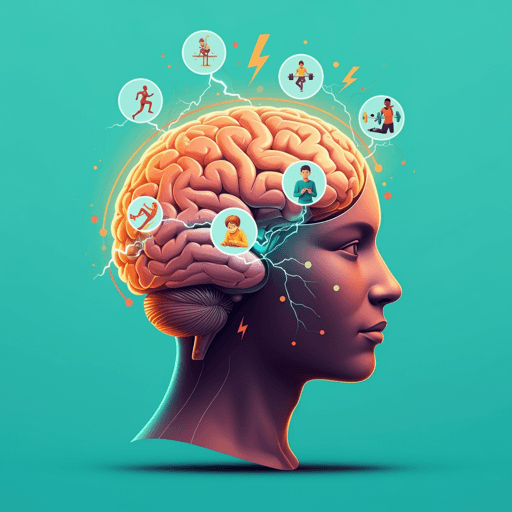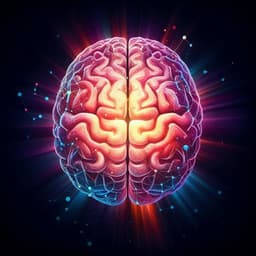
Health and Fitness
Effectiveness of exercise for improving cognition, memory and executive function: a systematic umbrella review and meta-meta-analysis
B. Singh, H. Bennett, et al.
Across 133 systematic reviews covering 2,724 RCTs and 258,279 participants, exercise—even light intensity—significantly improved general cognition (SMD=0.42), memory (SMD=0.26) and executive function (SMD=0.24). Benefits were larger for children/adolescents, low–moderate intensity, short interventions and exergames. Research conducted by Ben Singh, Hunter Bennett, Aaron Miatke, Dorothea Dumuid, Rachel Curtis, Ty Ferguson, Jacinta Brinsley, Kimberley Szeto, Jasmine M Petersen, Claire Gough, Emily Eglitis, Catherine EM Simpson, Christina L Ekegren, Ashleigh E Smith, Kirk I Erickson and Carol Maher.
~3 min • Beginner • English
Introduction
The study investigates whether exercise improves cognitive outcomes—general cognition, memory and executive function—across the lifespan and health statuses. Cognitive function is central to daily functioning and well-being, and cognitive decline and neurodegenerative diseases are major public health concerns. While exercise is known to confer substantial physical health benefits, growing evidence suggests benefits for cognitive health and mental well-being. Existing systematic reviews often focus on specific subgroups (e.g., children, older adults) or exercise types (e.g., resistance training, yoga), limiting generalisability. Prior umbrella evidence was restricted to healthy populations and found inconclusive or negligible effects after accounting for publication bias, leaving uncertainty about effects in clinical populations and across diverse exercise modalities. This umbrella review aims to comprehensively synthesise systematic reviews and meta-analyses of RCTs evaluating exercise effects on cognition, memory and executive function across all ages and populations, including clinical groups and a broad range of exercise modalities (e.g., aerobic, resistance, mind-body, dance, exergames).
Literature Review
A previous umbrella review by Ciria et al. reported a small positive effect of exercise on cognition (d=0.22, 95% CI 0.16 to 0.28) that became negligible after correcting for publication bias (d=0.05, 95% CI −0.09 to 0.14). Their analyses, including moderator exploration (age, sex, baseline activity, intensity, type, duration, cognitive domain), remained inconclusive and were limited to healthy participants, excluding clinical populations likely to benefit most. They also did not include mind-body exercises such as yoga or Tai Chi. These gaps motivated a broader synthesis encompassing clinical and non-clinical populations across the lifespan and additional modalities (e.g., exergames, mind-body).
Methodology
Protocol and registration: Preregistered on PROSPERO (CRD42023468991) and reported according to PRISMA 2020.
Eligibility (PICOS): Population: any human population (children, adolescents, adults; healthy or clinical). Intervention: planned, structured, repetitive exercise training ≥4 weeks (e.g., aerobic, resistance, yoga, dance, Tai Chi, exergames), with ≥75% of included RCTs focusing solely on exercise. Comparator: ≥75% of included RCTs compared exercise to no/waitlist/usual care/sham/equal-attention non-exercise/lower-dose exercise. Outcomes: any assessment of general cognition, memory or executive function. Study type: systematic reviews including meta-analyses; reviews including non-RCTs or acute single-bout studies were excluded.
Search strategy: Eleven databases (CINAHL, Cochrane Library, Embase via OVID, MEDLINE via OVID, Emcare via OVID, ProQuest Central, ProQuest Nursing and Allied Health Source, PsycINFO, Scopus, Sport Discus via EBSCOhost, Web of Science) from inception to 1 November 2023; English, peer-reviewed. Search terms combined subject headings/keywords/MeSH for systematic review, meta-analysis, cognitive function, memory, executive function and exercise. Duplicates removed in EndNote; screening in Covidence.
Screening and data extraction: Dual independent screening at title/abstract and full text, with conflicts resolved by discussion/third reviewer. Dual extraction of study, population, intervention characteristics, outcomes and results. Risk of bias of reviews assessed with AMSTAR-2 (16 items; critical and non-critical domains) and categorised as high, moderate, low or critically low confidence.
Overlap assessment: Corrected Covered Area (CCA) to quantify overlap of component RCTs across reviews; thresholds: slight (0–5%), moderate (6–10%), high (11–15%), very high (>15%).
Synthesis and meta-meta-analysis: Pooled effect sizes (and 95% CIs) reported by each review using random-effects models (restricted maximum likelihood). Primary effect measure: standardised mean difference (SMD). Mean differences (MD) used when sufficient data were available. Cognitive tests were categorised via the Cattell-Horn-Carroll-Miyake model; working memory measures were classified as executive function. Heterogeneity quantified with I² (0–29% none; 30–49% moderate; 50–74% substantial; 75–100% considerable). SMD magnitude: <0.20 small; 0.20–0.50 medium; >0.50 large. Significance threshold p<0.05.
Subgroup analyses: By age group (children/adolescents, adults, older adults ≥65), population (general population; cognitive impairment; clinical/chronic disease; specific conditions such as ADHD, stroke, neurological disorders, cancer), exercise mode (aerobic, resistance, mixed, mind-body [yoga, Tai Chi], dance, exergames, other), intensity (low, moderate, moderate-to-vigorous, vigorous), intervention length (1–3 months, 4–6 months, >6 months), session frequency (1–2/wk, 3–5/wk, 6–7/wk), session duration (<30 min, 30–60 min, >60 min), weekly duration (<150 vs ≥150 min/wk) and AMSTAR-2 confidence rating.
Publication bias and sensitivity: Funnel plots and trim-and-fill for analyses with ≥10 studies; estimated true effects (θ) reported. Post hoc sensitivity analyses included exclusion of a meta-analysis (Stanmore et al.) with methodological issues.
Evidence grading: Oxford Centre for Evidence-based Medicine levels and grades for recommendations were applied; consistent Level 1 evidence corresponds to Grade A.
Key Findings
Study selection and characteristics:
- Included 133 systematic reviews comprising 2,724 unique RCTs and 258,279 participants; overall CCA=0.78% (slight overlap). Over half of reviews first-authored from China. Most reviews evaluated mixed-mode exercise; single-mode reviews included aerobic (n=7), resistance (n=5), Tai Chi (n=5), dance (n=5), exergames (n=4), yoga (n=2), Baduanjin (n=2).
- AMSTAR-2 ratings: critically low (n=94), low (n=19), high (n=20). Common limitations: lack of full-text exclusion lists and funding source descriptions.
Pooled effects (random effects; SMD unless stated):
- General cognition (107 meta-analyses; n=82,742): SMD=0.42 (95% CI 0.37 to 0.47), I²=82.73%, p<0.01. MDs: MMSE=+1.54 (95% CI 1.11 to 1.98), MoCA=+2.31 (1.98 to 2.64), ADAS-Cog=−1.48 (−2.54 to 0.41; negative indicates improvement). Grade of recommendation: A (consistent Level 1).
- Memory (62 meta-analyses; n=50,975): SMD=0.26 (95% CI 0.20 to 0.32), I²=78.16%, p<0.01. MDs: Wechsler Memory Scale=+10.71 (4.22 to 17.21); Verbal Learning Test=+1.08 (0.73 to 1.43). Grade A.
- Executive function (117 meta-analyses; n=107,242): SMD=0.24 (95% CI 0.21 to 0.27), I²=70.34%, p<0.01. MDs: Digit Span (overall)=+0.92 (0.29 to 1.55); Digit Span-Backward=+0.15 (−0.14 to 0.43); Digit Span-Forward=+0.40 (0.22 to 0.58); TMT-A=−2.03 (−5.47 to 1.41); TMT-B=−8.68 (−15.48 to −1.88). Grade A.
Subgroup analyses:
- Age:
• General cognition: benefits across adults, mixed children/adults, and older adults (SMD 0.28–0.42); no significant between-group difference (Qb(2)=4.09, p=0.13).
• Memory: children/adolescents showed larger improvements (SMD=0.85) vs adults and older adults (SMD 0.18–0.27) (Qb(3)=19.16, p<0.01).
• Executive function: largest benefits in children/adolescents (SMD=0.36) vs others (SMD 0.18–0.23) (Qb(3)=8.19, p=0.04).
- Population:
• General cognition: consistent benefits across clinical groups (SMD 0.28–0.47); no significant differences (Qb(5)=3.93, p=0.56).
• Memory: generally consistent across populations (SMD 0.13–0.38); borderline group difference (Qb(4)=9.62, p=0.05).
• Executive function: ADHD showed the largest effects (SMD=0.72) vs cognitive impairment/dementia, general population, neurological disorders, other chronic disease, stroke, depression (SMD 0.13–0.25) (Qb(6)=48.09, p<0.01).
- Exercise mode:
• General cognition: exergames SMD=0.61; other modes small-to-moderate (SMD 0.25–0.44) (Qb(6)=19.38, p<0.01).
• Memory: exergames SMD=0.58; aerobic/dance/mind-body/mixed/resistance SMD 0.13–0.51 (Qb(5)=28.02, p<0.05).
• Executive function: ‘other’ exercise SMD=0.45 vs aerobic/dance/exergames/mind-body/mixed/resistance SMD 0.12–0.37 (Qb(6)=13.29, p=0.04).
- Exercise intensity: No significant subgroup differences for general cognition (Qb(3)=2.61, p=0.46), memory (Qb(2)=1.40, p=0.50), or executive function (Qb(3)=3.69, p=0.30), although effects tended to be larger at low-to-moderate intensities.
- Intervention length: 1–3 months largest for general cognition (SMD=0.39) vs 4–6 months and >6 months (SMD 0.20–0.30) (Qb(2)=7.53, p=0.02). No significant differences for memory (Qb(2)=2.12, p=0.35) or executive function (Qb(2)=0.67, p=0.72).
- Session frequency, duration, weekly minutes: no significant differences across categories.
- Risk of bias rating: Larger effects observed in critically low-confidence reviews vs low/high confidence (e.g., general cognition SMD 0.43 vs 0.23–0.38; memory 0.30 vs 0.13–0.22; executive function 0.26 vs 0.16–0.19).
Publication bias and sensitivity:
- Funnel plots indicated asymmetry; estimated true effects θ: general cognition d=0.31, memory d=0.24, executive function d=0.20.
- Sensitivity excluding Stanmore et al. altered certain mode-specific pooled effects (e.g., general cognition from 0.61 to 0.70; executive function from 0.37 to 0.26), supporting robustness of conclusions.
Overall, findings support small-to-moderate cognitive benefits of exercise across domains and populations, with strongest effects for children/adolescents (memory/executive) and ADHD (executive), and notable benefits from exergames and mind-body modalities.
Discussion
This umbrella review synthesised a broad evidence base across 133 systematic reviews to address whether exercise improves general cognition, memory and executive function in diverse populations. The pooled analyses demonstrate small-to-moderate benefits across domains and ages/health statuses. Crucially, benefits persisted when lower-quality reviews were excluded and after accounting for publication bias, indicating robustness. Compared with a prior umbrella review confined to healthy populations that reported negligible effects after bias correction, this review’s broader scope (clinical and non-clinical groups, additional modalities) reveals consistent, clinically relevant gains.
Potential mechanisms include physiological pathways (increased neurotrophic factors, enhanced cerebrovascular function, synaptic plasticity, reduced inflammation) and psychological/cognitive engagement (social interaction, dual-task demands). Exergames may amplify general cognition by combining physical exertion with cognitively demanding tasks. Mind-body exercises appear particularly beneficial for memory, possibly due to attentional control and memorisation of complex sequences. While low-intensity interventions often showed larger effects, intensity per se may be less critical than the cognitive engagement embedded in activities like Tai Chi, yoga and exergames. Shorter interventions (1–3 months) were more efficacious for general cognition, potentially reflecting better adherence, novelty effects, or control group differences, with no clear dose-response by frequency, duration or weekly minutes.
These findings support integrating exercise into clinical and public health strategies to promote cognitive health across the lifespan. They also highlight the need to disentangle the relative contributions of physical intensity versus cognitive engagement and to employ sensitive cognitive assessments suitable for healthy adults to detect subtle changes.
Conclusion
Exercise confers significant, broadly generalisable benefits on general cognition, memory and executive function across ages, populations and exercise modalities. Exergames and mind-body practices emerge as particularly promising for certain domains, and even light-intensity activities are beneficial, supporting inclusive, accessible recommendations. Clinicians and public health practitioners can confidently promote regular exercise for cognitive health. Future research should prioritise high-quality systematic reviews and RCTs with rigorous controls, sensitive and standardised cognitive measures (especially in healthy middle-aged adults), and designs that separate physical intensity from cognitive engagement to refine optimal prescriptions.
Limitations
- Substantial variability in cognitive assessment tools across and within reviews; some instruments (e.g., MMSE, MoCA, ADAS-Cog) are designed for impairment screening and may show ceiling effects in healthy adults, limiting sensitivity and contributing to heterogeneity.
- Many meta-analyses pooled different cognitive tests that may index distinct domains, adding methodological heterogeneity.
- Predominance of critically low AMSTAR-2 ratings (71%) among included reviews raises concerns about transparency and potential biases at the review level (not necessarily the underlying RCTs). Nevertheless, exclusion of lower-quality reviews did not change the direction or significance of effects.
- Limited evidence specifically targeting healthy middle-aged adults, often combined with older adults or clinical cohorts, hampers domain-specific inferences for this demographic.
- Shorter interventions may involve less rigorous control conditions and possible learning effects, complicating interpretation of larger short-term gains.
- Some sensitivity results depend on mode-specific meta-analyses (e.g., exergames), and publication bias was evident from funnel plot asymmetries.
Related Publications
Explore these studies to deepen your understanding of the subject.







